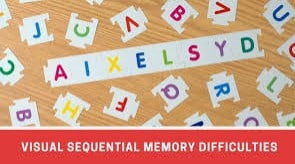Sequential memory is the ability to remember a series of forms and find it among other forms. If your child is having a hard time sequencing the alphabet, or copying from one place to another, this may be a problem with sequential memory. Sometimes, even with older primary school aged children, when they’re copying sentences off the board, they will skip words. Or, when a child is copying sentences, they’re copying one letter at a time. They’re not seeing it as a whole word that they can write, but just each individual letter. This is a sequential memory problem.
THERE ARE LOTS OF ACTIVITIES THAT CAN HELP YOUR CHILD TO IMPROVE THEIR VISUAL SEQUENTIAL MEMORY SKILLS:
-Play word games such as hangman, word searches or crossword puzzles.
-Practise memorising sequences of objects, shapes or colours. For those not yet familiar with letters or words, visual sequential memory can be developed by stringing bead patterns on necklaces, memorising sequences of shapes or by remembering a series of objects (e.g., a shopping list).
-Talk about your day with your child and then recall each other’s events.
-Practise finding patterns in letters, numbers, shapes or objects within a sequence to help remember it. It may help to look for patterns or repeated parts. This streamlines the memory process by reducing the number of units the child needs to remember.
-Use prepared flash cards or pieces of paper with pictures of familiar objects pasted on them, one object per page. Begin by showing your child three flash cards sequentially, allowing one second for each card, then ask the child to name the items in the order they were seen. As sequential memory improves, increase the number of cards for each round.
-Use visual images to help your child remember information in a particular order. A useful activity for children is to place a number of images (three or four to begin with) that relate to a specific subject and ask them to tell a story about the images, linking one to the next but using the correct name for each image. Remove the cards and take a short break, then ask your child to retell the story. Increase the number of images displayed as your child becomes more confident.
-To build auditory sequential memory, play a game of repeat after me. For young children, use one syllable words they easily recognise, beginning with two words, such as “cat” and “mouse”. Ask the child to repeat the words in the same order that you said them. Increase the number of words repeated one at a time. How many words can you remember correctly?
-You can use clapping or stomping patterns with older children. Clap a specific sequence, such as “clap-clap-pause-clap,” and ask the child to repeat it. As the child masters sequences of four beats, increase to longer sequences.

